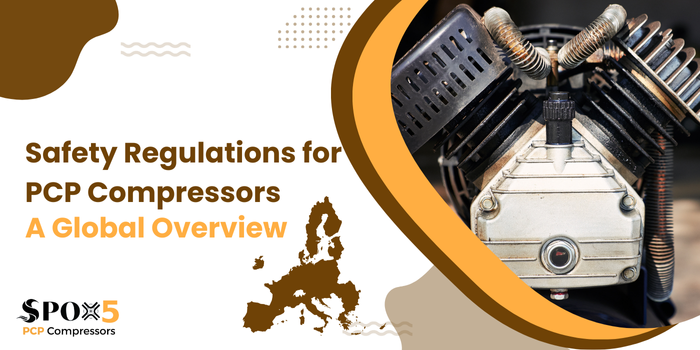PCP (progressing cavity) compressors are workhorses in various industries, handling fluids, slurries, and even solids with ease. However, their ability to generate high pressure demands robust safety regulations to prevent accidents and injuries. This blog delves into the global landscape of PCP compressor safety regulations, highlighting key commonalities and regional variations.
Understanding these regulations is crucial for anyone involved in the selection, installation, operation, and maintenance of PCP compressors.
The Need for Safety Regulations
PCP compressors operate under high pressure, and any malfunction or improper handling can lead to severe consequences. Here are some potential hazards associated with PCP compressors if not addressed through safety regulations:
- Pressure Vessel Rupture: Failure of the pressure vessel due to excessive pressure, corrosion, or material fatigue can cause explosions, shrapnel ejection, and potential fatalities.
- Leakage and Gas Emissions: Leaks can release compressed air or hazardous gases, creating safety risks and potential environmental damage.
- Electrical Hazards: Electrical components within the compressor can pose a risk of shock or fire if not properly maintained or installed according to safety standards.
- Noise Pollution: PCP compressors can generate significant noise levels, potentially causing hearing damage and requiring proper noise control measures.
Stringent safety regulations help mitigate these risks and ensure the safe operation of PCP compressors across various applications.
Global Regulatory Landscape: A Balancing Act
While the core principles of PCP compressor safety remain consistent around the world, specific regulations may differ based on regional factors:
- Level of Development: Developed countries often have more extensive and stricter safety regulations compared to developing nations.
- Industry Standards: Industry-specific standards set by organizations like the American Society of Mechanical Engineers (ASME) or the American Petroleum Institute (API) can influence national regulations.
- Regional Variations: Regulatory frameworks may differ slightly within continents. The European Union (EU) has its harmonized standards, while individual Asian countries might have their own sets of regulations.
Here’s a glimpse into some prominent global regulatory bodies:
- European Union (EU): The Pressure Equipment Directive (PED) 2014/68/EU governs the safety of pressure equipment, including PCP compressors. It categorizes compressors based on pressure and volume and sets safety requirements for design, manufacturing, and conformity assessment.
- United States: The Occupational Safety and Health Administration (OSHA) has regulations focused on workplace safety. While not directly addressing PCP compressors, OSHA standards like 29 CFR 1910.178 (Compressed Air and Gas Equipment) indirectly impact their use and maintenance. Additionally, industry standards like ASME Boiler and Pressure Vessel Code (BPVC) play a significant role in PCP compressor safety.
- China: The Administration of Special Equipment Safety (AQSIQ) sets safety requirements for pressure vessels and related equipment, including PCP compressors. These regulations focus on manufacturing, testing, and inspection of pressure vessels.
Key Commonalities in Safety Regulations
Despite regional variations, some key themes persist across most PCP compressor safety regulations globally:
- Pressure Vessel Design and Construction: Regulations typically mandate specific design and construction standards for pressure vessels used in PCP compressors. These standards ensure the vessel can safely withstand the intended pressure loads.
- Material Selection: Regulations often specify acceptable materials for pressure vessel construction, considering factors like strength, corrosion resistance, and compatibility with the compressed fluid.
- Manufacturing and Testing: Stringent quality control measures are often mandated during the manufacturing process to ensure the pressure vessel meets safety standards. This can involve non-destructive testing (NDT) to identify potential defects.
- Safety Relief Devices: Regulations require the installation of safety relief devices like pressure relief valves (PRVs) on PCP compressors. These valves automatically release excess pressure, preventing catastrophic vessel rupture.
- Operator Training: Regulations often emphasize the importance of operator training in safe and proper PCP compressor operation, maintenance, and troubleshooting.
Importance of Staying Informed
The world of regulations can be complex and subject to change. Here’s what you can do to ensure you stay informed:
- Consult the Manufacturer’s Instructions: Always refer to your specific PCP compressor model’s user manual for safety guidelines and any regional compliance information provided by the manufacturer.
- Check Regulatory Websites: Government websites for relevant regulatory bodies often provide access to the latest standards and directives.
- Seek Expert Advice: For complex applications or regulatory doubts, consult with qualified engineers or safety professionals specializing in pressure equipment.
Conclusion
Understanding and adhering to safety regulations is paramount for anyone involved in the use of PCP compressors. By staying informed about global and regional regulations, you can contribute to a safe working environment and ensure the reliable and efficient operation of your PCP compressor.

